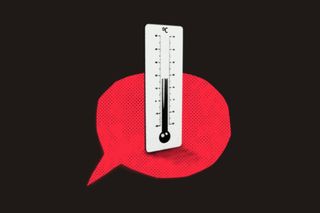
How the Climate Subtly Shapes the Way We Talk
In areas with high humidity and warm temperatures, people tend to use more vowels in their speech, the researchers found.

Where we live can affect the way we talk — whether it’s the language we speak, how we pronounce certain words, or which words and phrases we are more inclined to use. A recent study — published in Frontiers in Psychology — alludes to that possibility.
Ian Maddieson, an adjunct research professor in the department of linguistics at University of New Mexico, who led the study, wanted to demonstrate the impact of our environment on the sound structure of the languages we speak. “Most of the properties of a language, as it’s spoken today, are inherited from earlier stages of the same language… They’re inherited from an older generation of speakers of the same language, but over long periods of time, spoken languages do subtly change shape,” Maddieson told Phys.org, explaining, “What we’re looking at are these subtle changes over a period of time. The idea was to basically look for what kinds of correlations there are between these design features of sound systems of languages and the properties of the environment in which they are spoken.”
In pursuance of this, the researchers gathered data on language and environmental factors — looking at things like humidity, altitude, temperature, precipitation, and vegetation density in different parts of the world, and analyzing their influence on the languages spoken in these regions. This led them to study over a thousand languages from around the world — spanning a timeline spread across 300 years.
“Ian went to great lengths to specifically build the linguistic data set to provide that geographic diversity. We tried to be intentional about making sure that we had languages in all environmental areas that are implicated in the potential development of these linguistic features,” said Karl Benedict, Maddieson’s co-author, and the director of Research Data Services at the College of University Libraries and Learning Sciences. “The representation of a diversity of languages were scattered geographically over the widest possible range of global environments.”
Related on The Swaddle:
How Making Fun of Cultural Stereotypes Keeps People From Bonding With Their Communities
As anticipated, the researchers were indeed able to find overarching patterns between the environment one resides in, and the way they speak. Broadly, the four patterns that emerged from the data they analyzed were: first, in areas with high humidity and warm temperatures, people tend to use more vowels in their speech; second, in regions of higher altitude, there was a marked tendency to use ejective consonants — also described as voiceless consonants — more frequently; third, regions with higher humidity also boasted of complex tone structures in their languages; fourth, warm areas that received more rainfall were found to have fewer complex consonants in their languages.
Explaining the findings, Maddieson said, “[A]t high altitude, you want to preserve the moisture in your vocal tract, so you use sounds that don’t involve connecting to the outside air. This is the kind of sound where the vocal folds are closed, so you’re isolating the air that’s in the mouth from the rest of the lungs or from connecting to the outside world.” Over time, these subtle changes in speech can accumulate and become part of a language’s characteristics.
Interestingly, human beings aren’t the only species whose speech is shaped by their immediate environment. Astounding as it sounds — since we haven’t really heard of linguistic diversity among other species of fauna — Maddieson notes, “There’s some research on bird song which shows that with birds that live in both urban and rural settings, the birds that live in urban areas tend to pitch their songs a little higher to get above the background noise of cars and things like that. We know that some species do adapt to these relatively recent changes because the lifespan of a bird is much less than human lifeform.”
This is an area scientists are just beginning to explore in depth. That also means there’s a lot more to learn yet; an example: will factors like climate change impact the way we communicate in future? The answers continue to elude researchers, underlining the need for deeper understanding of the phenomenon of climates shaping the way we speak.
Devrupa Rakshit is an Associate Editor at The Swaddle. She is a lawyer by education, a poet by accident, a painter by shaukh, and autistic by birth. You can find her on Instagram @devruparakshit.
Related


Anger About Climate Change Is Actually Productive, Says Research
